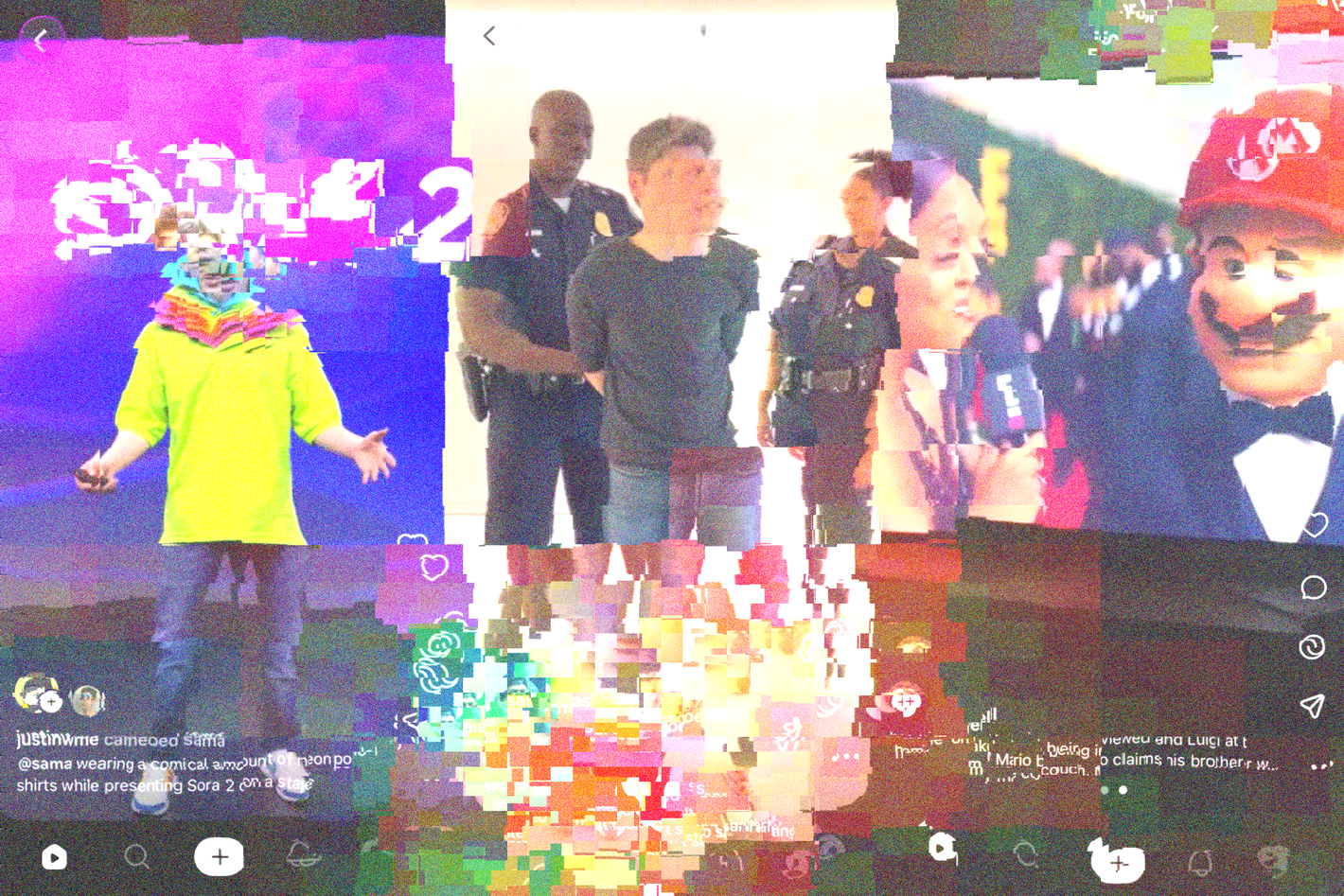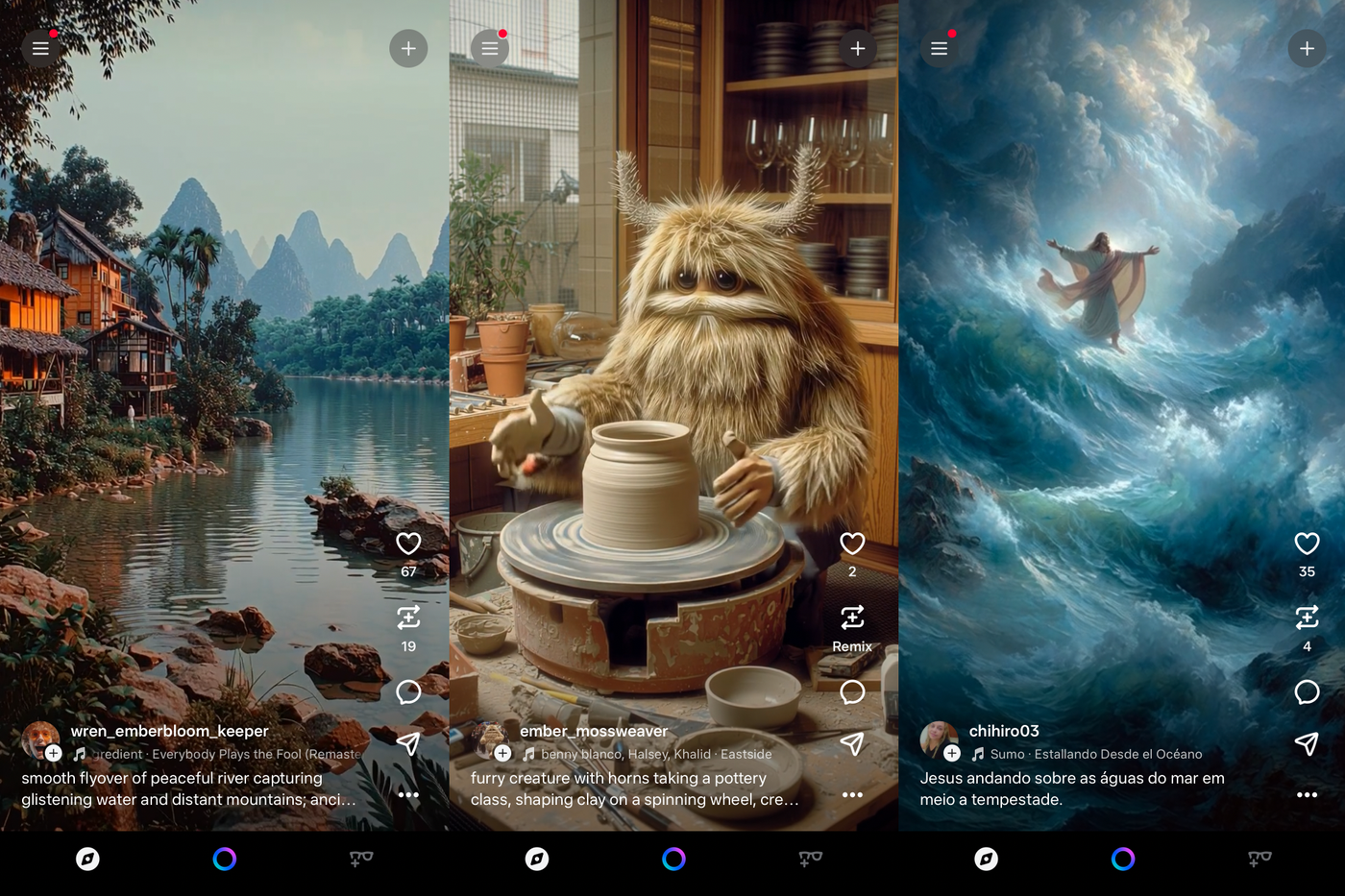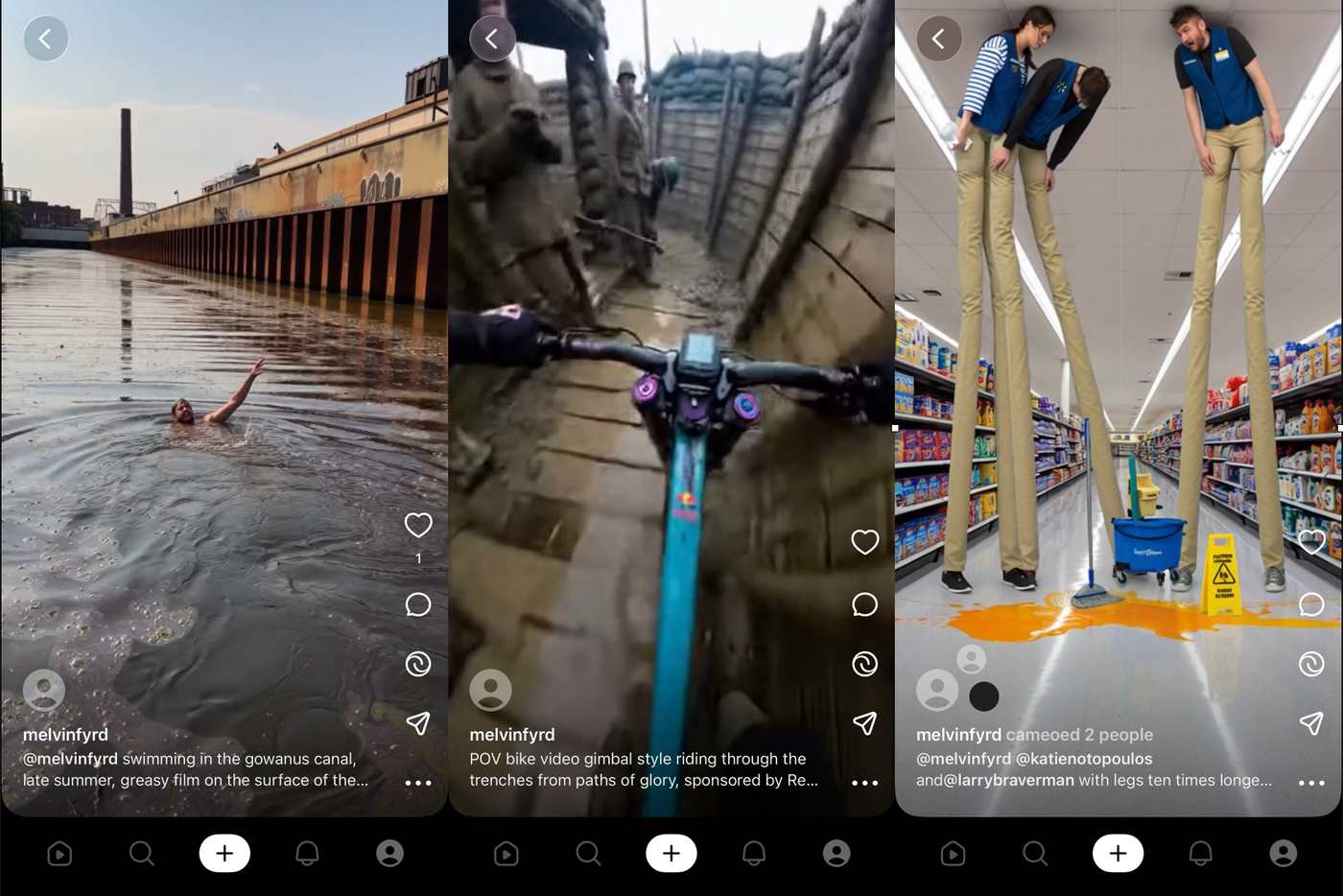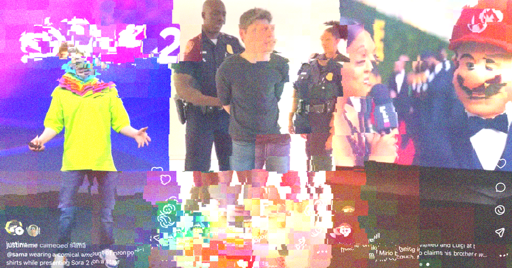
Photo-Illustration: Intelligencer; Photo: Sora
Last week, Meta’s newly appointed chief AI officer, Alexandr Wang, who co-founded the AI data-collection and annotation firm Scale.ai, announced Vibes, “a new feed in the Meta AI app for short-form, AI-generated videos.” Early responses were basically unanimous: What? Why? In testing, it felt, at most, like a chance to try out recent clip-generation tech for free. Otherwise, the feed was unfocused and confusing, full of overcooked generations by strangers unified only by the drab meta-aesthetics that have come to define AI imagery over the last couple of years: CGI-ish scenery and characters; real places and people rendered as uncanny stock photography; the work of Thomas Kinkade if he got into microdosing mushrooms. Even the more positive reviews couldn’t help but call it a feed of slop.

Photo: Vibes
In hindsight, though, the release of Vibes now makes a little more sense. Meta, which has been spending massive amounts of money to poach talent from other AI firms, probably knew a great deal about what OpenAI was about to release: a new version of its video-generation product, Sora, this time packaged as a TikTok-style app, dropped on Tuesday. In contrast with Vibes, Sora — an invite-only app with limited access — was an instant viral hit.
Lmao, Sam Altman stealing art from Miyazaki in the Studio Ghibli HQ.Sora 2 is wilddddddd. pic.twitter.com/qzhfMs0A2t
— PJ Ace (@PJaccetturo) October 1, 2025
What’s the difference? Underlying models matter a little bit here. In an apparent rush to get the app out, and lacking better tech of its own, Meta ended up leaning on an outside image-and-video-generation company. Meanwhile, the latest OpenAI model is obviously more capable of producing what you ask it for, whether that’s a fairly realistic clip of a real person doing something normal, a jokey visual mash-up — or something stranger or more illicit, despite OpenAI’s attempts to include a wide range of guardrails. Early examples going around on social media included macabre or gross videos, the nonconsensual likenesses of public figures, and copyrighted characters. The Sora videos tended to feel either shockingly good, sort of grimy, or both (its own easily circumventable rules are notable, but as much as anything make it impossible to ignore the vastly more dire possibilities that already exist beyond the platform, courtesy of open and increasingly capable video-generation models).
What really made the app work, however, were two features. One encouraged users to create avatars of themselves, called Cameos, which could then be included in videos. The other was the ability to, with users’ permission, include their Cameos in your videos. Some of the first videos to get momentum on Sora were people making jokes about Sam Altman, commanding his avatar into various absurd, embarrassing, or simply unexpected situations.
it is way less strange to watch a feed full of memes of yourself than i thought it would be.not sure what to make of this.
— Sam Altman (@sama) October 1, 2025
Far more compelling, though, was to try Sora with people you know. If the sanctioned (and ultimately flattering) ritual of teasing OpenAI’s CEO with his own product as it harvested users’ likenesses defined early popular content, the experience of actually using the app was defined by stranger and more personal experiences. Oh, there’s a version of me, looking and sounding slightly wrong but uncomfortably familiar, operating at my command. Oh, I can include a friend in this one, and I can make him say or do whatever we want.
Sora, the model, is a tech demo. Sora, the feed, is an experiment tucked into a TikTok clone, only somewhat more interesting than Vibes. Sora, the consensual deep-fake automator, makes the most sense in the context of a group chat, or within the app in little-noticed interactions between friends. Messing around with your own avatar is unsettling, interesting, and entertaining, an in the queasy tradition of social-media face filters or those old apps that used “AI” to make you look old in exchange for your privacy. Messing around with the avatars of people you know, together, is startling and fun. Using Sora is a bit like dressing up as one another for Halloween: It’s easy to get a laugh and easy to go a little bit too far.

Photo: Sora
Sora is presumably extremely expensive to run, hence OpenAI’s use of a chained invite program to roll it out. In its early form, it brings to mind the early days of image generators like Midjourney, the video model for which Meta is now borrowing for Vibes. Like Sora, Midjourney in 2022, was a fascinating demo that was, for a few days, really fun to mess with for a lot of the same reasons:
A vast majority of the images I’ve generated have been jokes — most for friends, others between me and the bot. It’s fun, for a while, to interrupt a chat about which mousetrap to buy by asking a supercomputer for a horrific rendering of a man stuck in a bed of glue or to respond to a shared Zillow link with a rendering of a “McMansion Pyramid of Giza…”
…I still use Midjourney this way, but the novelty has worn off, in no small part because the renderings have just gotten better — less “strange and beautiful” than “competent and plausible.” The bit has also gotten stale, and I’ve mapped the narrow boundaries of my artistic imagination.
Playing with Sora is a similar experience: a destabilizing encounter with a strange and uncomfortable technology that will soon become ubiquitous but also rapidly and surprisingly banal. It also produces similar results: a bunch of generations that are interesting to you and your friends but look like slop to anyone else. The abundant glitches, like my avatar’s tendency to include counting in all dialogue, help make the generations interesting. Many of the videos that are compelling beyond the context of their creation are interesting largely as specimens or artifacts — that is, as examples of how a prompt (“sam altman mounted to the wall like a big mouth Billy bass, full body”) gets translated into … something. (As one friend noted, many of these videos become unwatchable if you can’t see what the prompt was.)
This makes Sora interesting to compare to more straightforwardly “social” networks, where most content is likewise produced for small audiences and lacks appeal beyond that context. Here, too, celebrities and brands are what people want to see, but with the expectation that they can be commanded and manipulated, not just consumed. Sora: It’s pretty fucking weird!
⚡ Sora 2 prompt: "Realistic body cam footage of a police officer pulling over a red Ferrari with Pikachu driving. pikachu only says “pika pika” and moves the head in fear, It was a serious offence, so the cop is extremely angry and tries to open the door of the car before… pic.twitter.com/F88WiD0s69
— Javi Lopez ⛩️ (@javilopen) October 2, 2025
It’s also clearly compelling, and it (or imitations of it) are going to confront way more people — soon. OpenAI’s willingness to release strange, glitchy preview products (and to gleefully violate norms in the process) is at this point an established strategy and one that has reliably netted it users (in the case of ChatGPT, which now has hundreds of millions of users) or at least renewed attention (as when OpenAI demonstrated new image-generation tools through a viral aesthetic rip-off campaign). In terms of the AI “alignment” debate, for whatever it’s worth, the leading AI firm optimizing its product output for engagement is somewhere between “bad” and “apocalyptic.” It’s also something that Meta, despite its reputation for engagement-at-all-cost product design, can’t seem to pull off no matter how hard it tries.
Not sure what’s more eye roll worthy, yet another short form video app, or moralizing people who talk about it like this is summoning the devil. Probably the former as it’s emblematic of incredible models being wasted on product managers with the vision/creativity of a turnip.
— Séb Krier (@sebkrier) October 1, 2025
most liked video on vibes made by a lena_whisperwinwith 190 followersmost of whom are bots pic.twitter.com/b5kZEWkt6W
— Susan Zhang (@suchenzang) September 26, 2025
In the broader discourse around what modern AI is for and where it might be going, it’s also useful to try to reconcile with some of the rhetoric from companies like OpenAI about why they need to raise so much money to build so many data centers. (For a glimpse of the view from within Google, see the above posts from people who work on AI there.) Are we trying to cure cancer? Obsolete knowledge workers? Build robots? Compete with Instagram? Buy some more runway? For now, the answer seems to be, “Hey, check out Sora, the app where you can make Sam Altman dance.”
From Intelligencer - Daily News, Politics, Business, and Tech via this RSS feed

